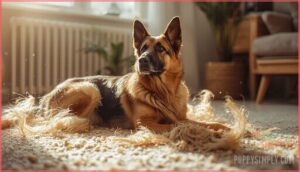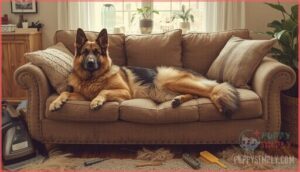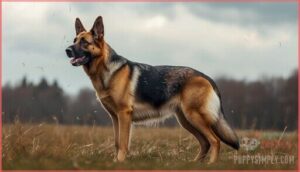This site is supported by our readers. We may earn a commission, at no cost to you, if you purchase through links.
 Your German Shepherd’s fur doesn’t just shed—it migrates. Tufts collect along baseboards, cling to your favorite sweater, and float through sunbeams like tiny tumbleweeds.
Your German Shepherd’s fur doesn’t just shed—it migrates. Tufts collect along baseboards, cling to your favorite sweater, and float through sunbeams like tiny tumbleweeds.
This isn’t poor grooming or a health crisis; it’s biology working exactly as designed. German Shepherds carry a double coat that cycles through constant renewal, with two major seasonal blowouts that can fill bags with undercoat fluff.
The shedding intensity varies based on coat genetics, indoor versus outdoor living, and even the length of your daylight hours. Understanding what triggers these hair avalanches—and when they’ll hit hardest—helps you manage the fur without battling it constantly.
Table Of Contents
- Key Takeaways
- Do German Shepherds Shed?
- Why Do German Shepherds Shed So Much?
- When Do German Shepherds Shed The Most?
- Managing German Shepherd Fur at Home
- Signs of Abnormal Shedding in German Shepherds
- Frequently Asked Questions (FAQs)
- What are the best vacuum cleaners for homes with German Shepherds?
- How often should I bathe my German Shepherd?
- What type of brush is best for grooming a German Shepherd?
- Should I give my German Shepherd fish oil supplements?
- Is it safe to shave my German Shepherd’s coat?
- Can spayed or neutered dogs shed differently?
- Do German Shepherd puppies shed less initially?
- Are there hypoallergenic German Shepherd mixes available?
- How does age affect shedding in seniors?
- Can indoor versus outdoor living change shedding?
- Conclusion
Key Takeaways
- German Shepherds shed year-round with two intense seasonal “blowouts” in spring and fall lasting 2-4 weeks, during which they can lose 15-20% of their undercoat mass—this isn’t abnormal, it’s how their double coat naturally regulates temperature in response to daylight and weather changes.
- Daily brushing during peak shedding removes up to 90% of loose hair before it spreads through your home, while strategic bathing every 4-6 weeks during heavy cycles and using deshedding tools can release 60% more fur during grooming sessions than brushing alone.
- Diet directly impacts shedding intensity—protein-rich food strengthens hair shafts, omega-3 supplements can reduce shedding by 30% within eight weeks, and proper hydration (50-60 mL per kg daily) keeps skin healthy and minimizes fur loss.
- Watch for warning signs beyond normal shedding: bald patches covering more than 10-15% of the body, persistent scratching with sores, or sudden hair loss paired with lethargy or appetite changes may indicate thyroid issues, infections, or autoimmune conditions requiring veterinary attention within 48 hours.
Do German Shepherds Shed?
If you’re considering a German Shepherd, you’ve probably heard they shed—but just how much are we talking about? The answer depends on a few key factors, including their coat type and the time of year.
Let’s break down what you can actually expect regarding shedding frequency, coat variations, and those intense seasonal cycles.
Shedding Frequency and Patterns
Your German Shepherd sheds constantly—there’s no off-season. Throughout all twelve months, you’ll find hair from both undercoat and guard layers as your dog maintains natural coat renewal.
Shedding frequency intensifies dramatically during seasonal peaks in spring and fall, when German Shepherds “blow” their entire undercoat over three to four weeks. These shedding phases align with temperature shifts, replacing winter insulation with summer breathability and vice versa.
Daily brushing during peak shedding season removes up to 90% of loose hair before it lands on your floors. Understanding the coat shedding process is essential for effective management and maintenance of your dog’s health.
Double Vs. Single Coat Types
Your German Shepherd’s coat type determines how much fur you’ll manage. Most German Shepherds sport a double coat—a dense undercoat beneath weather-resistant guard hairs—designed for thermal regulation across extreme climates. This dual-layer structure means markedly more shedding than single-coated variants.
Here’s what distinguishes the two coat types:
- Double-coated dogs shed continuously year-round, with intense seasonal coat blows increasing hair loss up to 300% during spring and autumn transitions.
- Single-layer German Shepherds lack the insulating undercoat, resulting in 50% lower annual fiber turnover and less household fur accumulation.
- Coat genetics follow simple inheritance—two copies of the recessive gene produce long coats, while dominant genes create the standard short stock coat.
Double-coated dogs require brushing up to five times weekly to manage undercoat density effectively. Understanding the double coat structure is vital for proper grooming and maintenance.
Seasonal Shedding Cycles
Once you understand coat types, seasonal shedding frequency becomes predictable. Your German Shepherd experiences two major coat blows annually—spring removes the winter undercoat, fall swaps summer fur for denser insulation. Each shedding season lasts 2–4 weeks, with peak intensity hitting within the first 10–14 days. Photoperiod effects and hormonal changes drive these cycles: longer daylight triggers spring shedding, shorter days initiate fall renewal.
| Shedding Season | Duration & Intensity |
|---|---|
| Spring (March–May) | 2–4 weeks; removes 15–20% undercoat mass |
| Fall (Sept–Nov) | 2–4 weeks; replaces summer coat with winter density |
| Year-Round | Continuous outer coat renewal between seasonal triggers |
Outdoor dogs show sharper shedding patterns due to natural seasonal triggers, while indoor dogs with artificial lighting shed more continuously year-round.
Why Do German Shepherds Shed So Much?
If you’ve ever watched a small tumbleweed of fur roll across your floor, you’re probably wondering what’s behind all that shedding. German Shepherds don’t shed excessively just to test your patience—there are real biological and environmental reasons at play.
Let’s look at what drives this natural process and why your dog seems to leave a trail of fur wherever they go.
The Purpose of Shedding
Think of shedding as your German Shepherd’s built-in coat maintenance system. This natural shedding cycle aids fur renewal by replacing damaged hair with fresh growth, while also serving a vital thermoregulation function.
Your dog’s double coat adjusts to temperature changes through seasonal shedding, ensuring proper insulation in winter and cooling during summer.
The hair growth process continuously removes debris and maintains skin health, making German Shepherd shedding essential for their overall well-being.
Coat Changes and Weather
Beyond temperature alone, your German Shepherd’s coat reacts to complex environmental cues that drive seasonal shedding patterns. Photoperiod effects—changes in daylight length—trigger the most dramatic coat transitions, particularly around spring and autumn equinoxes.
Key weather adaptation factors include:
- Daylight cycles: Longer days prompt winter undercoat loss; shorter days signal denser coat growth
- Temperature shifts: Rising warmth accelerates spring shedding; autumn cold increases coat thickness
- Humidity levels: High moisture can intensify shedding frequency and affect coat texture
- Climate influence: Indoor dogs with artificial lighting shed more steadily year-round than outdoor dogs
- Weather extremes: Sudden temperature swings may trigger irregular double coat transitions
Your dog’s shedding in winter and summer reflects these climate adaptations, ensuring ideal insulation and thermoregulation throughout the year.
Health and Genetic Factors
Your German Shepherd’s shedding isn’t random—genetic mutations affecting skin barrier proteins can increase vulnerability to coat disorders, while hormonal imbalances from thyroid issues or spaying may trigger patchy hair loss.
Nutrient deficiencies in omega fatty acids and zinc compromise coat quality, and autoimmune disorders like lupus cause symmetrical alopecia.
Skin infections from bacteria or fungi accelerate shedding too, making health problems significant genetic factors beyond normal coat renewal.
When Do German Shepherds Shed The Most?
German Shepherds don’t shed at a steady pace throughout the year—there are peak times when you’ll notice much more fur around your home.
Understanding when shedding ramps up helps you prepare and adjust your grooming routine accordingly. Let’s break down the timing and what drives those heavier shedding periods.
Blowing The Undercoat in Spring and Autumn
Twice a year—spring and autumn—your German Shepherd will blow their undercoat in dramatic fashion. This coat renewal usually lasts two to four weeks as photoperiod changes and warmer or cooler temperatures trigger massive fur loss.
You’ll notice tufts of soft, dense undercoat coming out in clumps, sometimes tripling normal shedding volume. This seasonal shedding pattern is your dog’s natural response to daylight shifts and temperature swings.
Daily Outer Coat Shedding
Between seasonal peaks, your German Shepherd sheds its outer coat daily—a steady background hum of fur that can fill a lint roller each day. Regular brushing 3–4 times weekly catches up to 90% of loose hair before it settles on your couch.
Consider these daily grooming essentials:
- Slicker brushes remove dead outer coat efficiently
- Weekly bedding washes eliminate accumulated fur
- Daily vacuuming reduces visible shed by 80%
This consistent fur reduction through brushing techniques prevents your home from becoming a fur landscape while supporting healthy coat maintenance.
Factors Influencing Shedding Intensity
Your dog’s German Shepherd shedding intensity isn’t just about the season—genetic factors, environmental impact, and nutritional effects all shape how much fur you’ll find on your floors. Dogs with specific coat genes shed 80% more than lighter variants, while indoor lighting disrupts natural shedding patterns by 30%. Hormonal influence from thyroid imbalances can spike shedding by over 30%, and diets lacking omega fatty acids increase hair loss by 35%.
| Shedding Triggers | Impact on Coat Health |
|---|---|
| Low humidity ( Your German Shepherd’s diet directly affects shedding—90% of each hair is keratin built from high-quality protein that strengthens fur and reduces breakage |
Omega-3 fatty acids from fish oil can drop shedding severity by 30% within eight weeks, while proper hydration levels—about 50–60 mL per kg daily—keep skin supple and reduce fur loss.
Vitamin support like E and biotin, plus mineral balance including zinc, support follicle health. Quality dog food beats filler-heavy kibble every time. Add Omega supplements if your dog food lacks natural oils, and always keep fresh water available.
Managing German Shepherd Fur at Home
Even with regular grooming, German Shepherd fur will find its way onto your floors, furniture, and clothing.
The good news is that a few smart strategies can make living with a heavy shedder much more manageable. Here’s how to keep your home cleaner and reduce the time you spend battling dog hair.
Effective Cleaning Strategies
Keeping on top of fur buildup means combining the right tools with consistent effort. German Shepherds shed constantly, so daily vacuuming—especially in high-traffic areas—removes loose hair before it embeds into furniture or carpets. Pet-friendly vacuums with specialized brushes capture fur more effectively, and machines designed for pet hair usually remove about 78% from carpets.
Between deeper cleans, try these quick strategies:
- Use lint rollers or rubber brooms on upholstery and hard floors
- Run microfiber cloths over surfaces weekly to trap floating particles
- Toss dryer balls into laundry cycles to loosen hair from fabrics
- Operate a HEPA air purifier continuously to reduce airborne dander by up to 90%
Rotating between vacuuming and manual tools like the ChomChom remover keeps your home noticeably cleaner without constant heavy lifting.
Pet-Friendly Furniture and Flooring
Your cleaning routine deserves furniture and flooring that work with you, not against you. Leather and microfiber sofas repel fur easily—leather wipes clean in seconds, while microfiber’s tight weave resists stains and scratching.
For flooring, porcelain tile or SPC vinyl offers scratch-proof, waterproof surfaces that handle shedding without absorbing odors.
Avoid faux leather (it peels quickly) and choose matte finishes for better traction, protecting your dog’s joints while simplifying home maintenance with a pet-friendly vacuum.
Clothing and Fabric Tips
Beyond furniture and tile flooring, your wardrobe choices matter. Smooth fabrics like leather, polyester, and nylon resist dog hair—synthetic textiles attract up to 65% less fur than cotton or wool.
Anti-static dryer sheets cut hair adhesion by 75%, while a quick no-heat tumble cycle before washing loosens 90% of clinging fur.
Keep a pet-friendly vacuum handy and store clothes in breathable garment bags for fur-proofing success.
Signs of Abnormal Shedding in German Shepherds
While some shedding is completely normal for German Shepherds, certain patterns can signal that something’s off with your dog’s health. Bald patches, irritated skin, or sudden increases in hair loss deserve a closer look. Here’s what to watch for and when it’s time to call your vet.
Common Health Issues and Skin Conditions
When your German Shepherd sheds more than usual or develops bald patches, skin conditions may be the culprit. These health issues often trigger excessive shedding alongside visible coat and skin changes:
- Atopic Dermatitis: This allergic disorder affects nearly 5% of dogs, causing chronic itching, inflamed skin, and patchy hair loss due to weakened skin barriers.
- Pyoderma Infections: Deep bacterial infections create painful, crusty lesions on the lower back and thighs, with over 90% linked to Staphylococcus bacteria.
- Autoimmune Diseases: Conditions like lupus erythematosus produce UV-sensitive sores and progressive fur thinning, especially before age five.
- Endocrine Influences: Hypothyroidism disrupts normal coat cycles, leading to dull, brittle fur and symmetrical hair loss across the body.
When to Seek Veterinary Advice
Sometimes, you’ll notice red flags that demand immediate attention. If your German Shepherd loses hair in patches covering more than 10–15% of their body, develops sores or scabs, or won’t stop scratching, schedule a veterinarian consultation within 48 hours.
Abnormal shedding paired with lethargy, weight loss, or appetite changes lasting over three days signals potential hypothyroidism or other serious dog health issues requiring diagnostic blood panels and skin evaluations.
Preventive Health and Grooming Practices
Your best defense starts with routine care. Annual wellness exams catch hip dysplasia and degenerative myelopathy in nearly half of senior German Shepherds, while biannual checkups improve early disease detection by up to 65%.
Brush your dog three to four times weekly using proper grooming tools to reduce German Shepherd shedding by 50%. Pair that with dental care every 12 months, monthly parasite prevention, and nutrition planning rich in omega-3s to keep their coat healthy and minimize abnormal shedding before problems start.
Frequently Asked Questions (FAQs)
What are the best vacuum cleaners for homes with German Shepherds?
You’ll want powerful suction and specialized tools to tackle the challenge. Look for models with anti-tangle brush rolls, HEPA filters, and large dustbins—like the Dyson V15 Detect or Shark PowerDetect—that handle heavy pet hair on furniture and floors efficiently.
How often should I bathe my German Shepherd?
You’ll want to bathe your German Shepherd every two to three months under normal conditions.
During heavy shedding seasons—spring and fall—consider bathing every four to six weeks using a gentle, pH-balanced dog shampoo to support coat health and manage loose fur effectively.
What type of brush is best for grooming a German Shepherd?
Think of your brush collection like a surgical kit—each tool has a specific job. For German Shepherd grooming, you’ll want slicker brushes to detangle and lift loose undercoat, deshedding tools like the Furminator to reach deep and remove up to 90% of dead fur, and rakes for those heavy spring and fall coat blows when they’re shedding like it’s going out of style.
Should I give my German Shepherd fish oil supplements?
Fish oil can help your German Shepherd’s shedding by nourishing skin and coat with omega-3 fatty acids.
Studies show these supplements reduce dryness and itching while supporting joint health—especially valuable for this breed prone to hip dysplasia and skin conditions.
Is it safe to shave my German Shepherd’s coat?
Shaving isn’t recommended—it compromises your dog’s natural insulation and weather protection, risking skin problems, sunburn, and problematic coat regrowth.
Instead, focus on regular brushing, deshedding tools, and proper German Shepherd grooming to manage shedding without causing coat damage or health consequences.
Can spayed or neutered dogs shed differently?
Yes, spayed or neutered German Shepherds can shed differently. Sterilization effects include hormonal changes that may shift shedding patterns from seasonal bursts to more consistent year-round dog shedding, and some dogs develop thicker, woollier coat texture post-surgery care.
Do German Shepherd puppies shed less initially?
German Shepherd puppies shed less initially because their soft puppy coat doesn’t shed much until they’re 4 to 6 months old.
That’s when the coat change begins, replacing fluffy fur with the denser adult coat—and shedding ramps up considerably.
Are there hypoallergenic German Shepherd mixes available?
No German Shepherd mix is truly hypoallergenic. Even crossbreeds like Shepadoodles still produce allergens.
Hybrid dogs may shed less, but coat genetics don’t eliminate dander entirely. Low-shedding breeds reduce exposure, not allergic reactions themselves.
How does age affect shedding in seniors?
As your German Shepherd ages, you’ll notice Senior Shedding Patterns shift—coat density loss accelerates, skin elasticity decreases, and hormonal effects intensify German Shepherd shedding.
Age-related changes reduce hair regeneration by roughly fifty percent, making routine grooming and targeted dog health care essential to managing these shedding habits effectively.
Can indoor versus outdoor living change shedding?
Living arrangements absolutely influence German Shepherd shedding patterns. Indoor humidity and climate control can dry out their coat, triggering more continuous year-round shedding.
Meanwhile, outdoor exposure to natural seasonal shifts intensifies their twice-yearly coat blows—spring and fall become shedding events. Temperature stability matters more than you’d think for managing dog shedding in summer and winter.
Conclusion
If only German Shepherds could read their own genetics manual, they might apologize for the fur avalanche. But nature designed this double coat for survival, not convenience—and no amount of wishful thinking will stop it.
The truth is, do German Shepherds shed? Absolutely, year-round and dramatically. Your job isn’t to eliminate shedding but to intercept it with smart grooming, strategic tools, and preventive health habits.
Master the rhythm of their coat cycles, and you’ll spend less time battling tumbleweeds and more time enjoying the dog beneath all that fluff.
- https://blog.petmade.com/do-german-shepherds-shed/
- https://www.groomers-online.com/how-to-groom-a-german-shepherd-i235
- https://pmc.ncbi.nlm.nih.gov/articles/PMC3649999/
- https://www.akc.org/expert-advice/health/tips-for-grooming-german-shepherd/
- https://pro.dermavet.com/german-shepherd-dog-skin-problems/










